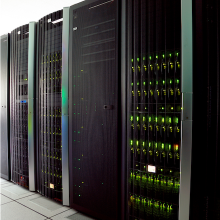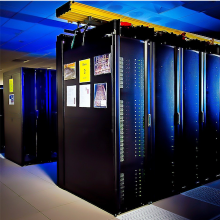Bioinformatics

EGI: HADDOCK, a biomolecular simulations platform
HADDOCK (High Ambiguity Driven protein-protein DOCKing) is an integrative platform developed at Utrecht University for the modelling of biomolecular complexes and is one of the WeNMR thematic services. HADDOCK can support complex simulation projects, and benefits from the distributed computing infrastructure of EGI. In the context of COVID-19 related research it can, for example, model interaction between virus proteins and human one, or support the docking of small molecules to targets such as the COVID-19 protease. The tool is offered by the Bijvoet Center of the Utrecht University, Netherlands, is supported by the EOSC-hub H2020 project and is also accessible through the European Open Science Cloud Portal.

LAPP: MUST data centre computational and storage capacities
The Particle Physics Laboratory of Annecy (LAPP), a joint research unit of CNRS and Savoie Mont-Blanc University, provides all the possible computational and storage support to the CNRS biologists with its MUST data centre, to contribute in the battle against the COVID-19 pandemic. Exceptionally, LAPP will offer special access to its MUST data centre for important insights into the behaviour of the virus. The computing power of MUST will be used for in-silico screening to select from a database of several million molecules, those that meet very precise specifications and that could attack some major COVID-19 enzymes responsible for the replication of the virus RNA in the human host cell.

GENCI: High performance computing and storage facilites
GENCI, the French HPC agency, is providing its HPC (high performance computing) and storage facilites (located into 3 national centers: TGCC for CEA, IDRIS for CNRS and CINES for French Universities), as well as the user support resources to researchers from academia and industry working on COVID-19. Such supercomputers are used to accelerate modelisation/simulation workloads, post-processing of massive amount of data and use at scale of artificial intelligence. Already 15 projects have been benefited from such fast track, in the fields of massive docking, development of vaccines and therapies, epidemiological research on the spread of the virus, and related applications.

CETAF and DiSSCo: Joint COVID-19 Task Force
The Consortium of European Taxonomic Facilities (CETAF) and the Distributed System of Scientific Collections (DiSSCo) are forming a covid-19 Task Force. The Task Force will bring together experts with background in topics relevant to the key aspects for the understanding of the zoonotic nature of the SARS-Cov-2 and contribute to the global efforts from the perspective of both key biological properties of the virus and biological informatics. The Task Force objectives are focused on (a) expediting processes across DiSSCo facilities related to the implementation of covid-19 projects, (b) mobilising ad-hoc data across the 120 museums and the more than 1 billion biological specimens and (c) facilitating access to laboratory equipment for analysis of relevant material.

CRESCO6: Free access to high-performance computers
The Italian National Agency for New Technologies, Energy and Sustainable Economic Development (ENEA), in order to contribute to research on COVID-19, makes its high-performance computing infrastructure HPC CRESCO6 available - free-of-charge access - to the entire scientific community involved in research activities and application projects for the coronavirus emergency.

SIB: Bioinformatics data services and analysis tools
The SIB Swiss Institute for Bioinformatics, Swiss node of ELIXIR and a partner of EMBL-EBI, undertakes a wide range of initiatives against SARS-Cov-2, providing data services and analysis tools that can help researchers answer the following questions:
- From where did the new coronavirus arise, and how did it move to humans?
- How is it spreading and evolving?
- How can we develop therapies to treat it?

EMBL-EBI: Biomedical data resources
In response to the current outbreak of COVID-19, EMBL-EBI is gathering and sharing data resources as they become available. Researchers can now see a breakdown of relevant data hosted at EMBL-EBI on the Pathogen Portal. This includes sequences of outbreak isolates and records relating to coronavirus biology. Researchers can also find instructions for submitting data to the European Nucleotide Archive (ENA). EMBL has recognised the urgency to identify and consolidate needs around creating a European COVID-19 Data Platform for data/information exchange, connected to the European Open Science Cloud (EOSC.

DeiC: Data storage and cloud resources
With the current COVID-19 situation, there is need for international cooperation on sharing information and making data available to research that that can contribute to alleviate the impacts of COVID-19 on citizens, healthcare systems and society. The University of Copenhagen/The Technical University of Denmark can make cloud resources, data storage space, etc. available as a flexible secure private cloud setup at Computerome. This also includes a data-lake facility, which can handle different data sets and types and the required storage space. This includes epidemiological information and sequencing data.

PRACE: Access to computing resources
PRACE (Partnership for Advanced Computing in Europe) is welcoming project proposals requesting computing resources to contribute to the mitigation of the impact of the COVID-19 pandemic. PRACE partners, HPC centres, and research infrastructures are doing their bit by opening up their facilities for urgent/priority access to the HPC systems and other resources to support the research to combat the coronavirus. Please find a list of these initiatives here.

ELIXIR: Life science data tools and resources
ELIXIR, the ESFRI Research Infrastructure for life science data, provides a range of services and resources, that can be used by researchers and consortia working on SARS-CoV-2 research via ELIXIR Nodes. ELIXIR has also initiated new community-driven initiatives (e.g. Hackathons) that help to open up and link COVID-19 data. As details become available, they will be published on the ELIXIR COVID-19 webpage linked below.
